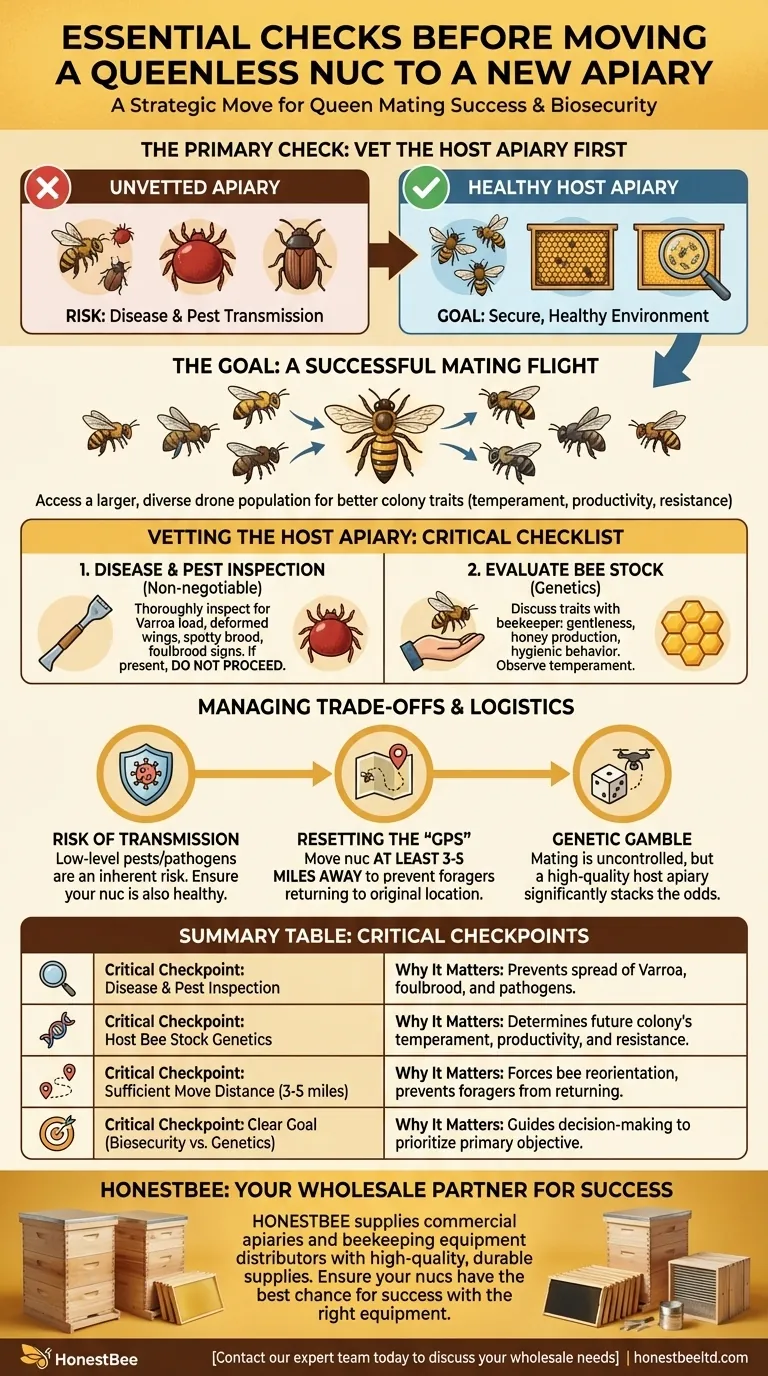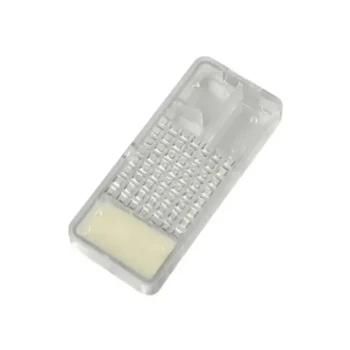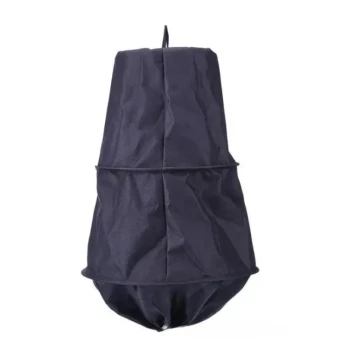Before all else, the primary checks before moving a queenless nuc to another beekeeper's apiary are to thoroughly inspect the host apiary and its colonies. You must ensure they are free from diseases and pests and confirm that the other beekeeper maintains a good, healthy bee stock. This action protects your bees and prevents the spread of potential problems.
Moving a queenless nuc is a strategic decision to improve queen mating success by accessing a larger drone population. However, this move carries significant biosecurity risks, making a rigorous inspection of the destination apiary the most critical step in the entire process.

The Goal: A Successful Mating Flight
Understanding why you're moving the nuc is key to understanding what to check. The goal is to get a new virgin queen successfully mated so she can become the productive heart of the colony.
Why Move the Nuc?
A queenless nuc, either one you created or one that is requeening itself, needs access to a large and genetically diverse population of drones.
If your own apiary is small (a common rule of thumb is fewer than ten colonies), there may not be enough drones for a successful mating flight. Moving the nuc to a larger, healthier apiary dramatically increases the odds.
The Critical Role of Drones
The virgin queen will fly out and mate with multiple drones from the surrounding area. The genetics of these drones will determine the traits—like temperament, productivity, and disease resistance—of your future colony.
The host apiary is your primary source for these crucial genetics.
Vetting the Host Apiary: Your Critical Checklist
Your inspection should be focused on two areas: the health of the bees and the quality of their genetics. Do not move your bees without performing these checks.
Prioritize Disease and Pest Inspection
This is a non-negotiable step. Moving bees is the number one way diseases and pests like Varroa mites, foulbrood, and hive beetles spread between apiaries.
Carefully inspect several of the host colonies. Look for signs of a high Varroa load, deformed wings, spotty brood patterns, or any other indicator of poor health. If you see any red flags, do not proceed.
Evaluate the Bee Stock (Genetics)
The quality of the host beekeeper's stock is paramount. You are essentially selecting the fathers for all future bees in your nuc.
Talk to the beekeeper about their stock. Ask about the traits they select for, such as gentleness, honey production, and hygienic behavior. Observe the bees' temperament during the inspection.
Understanding the Trade-offs
Moving bees is an effective strategy, but it comes with inherent risks and logistical considerations that you must manage.
The Inherent Risk of Transmission
Even a healthy-looking apiary can harbor low levels of pests or pathogens. You are accepting a degree of risk that your nuc may pick something up. Likewise, you have a responsibility to ensure your own nuc is healthy before moving it.
Resetting the Bees' "GPS"
To prevent the nuc's foraging bees from flying back to their original home, the move must be over a sufficient distance.
A common guideline is to move the nuc at least 3-5 miles away. This forces the bees to reorient themselves to the new location and its resources, ensuring the nuc remains a cohesive and functional unit.
The Genetic Gamble
While you can vet the host apiary, a queen's mating flight is uncontrolled. She will mate with drones from a wide radius, not just from the hives in that specific yard.
However, by choosing a high-quality host apiary, you significantly stack the genetic odds in your favor.
Making the Right Decision for Your Nuc
Your final decision should be based on a clear-eyed assessment of risk versus reward.
- If your primary focus is biosecurity: Do not proceed unless you are completely confident the host apiary is free of significant disease and pest pressure.
- If your primary focus is genetic improvement: Choose a host apiary managed by a beekeeper who actively selects for desirable and locally-adapted traits.
- If your primary focus is immediate mating success: Select a large, thriving apiary with many strong colonies to ensure a high concentration of available drones.
A successful move is defined by a healthy, well-mated queen and a thriving new colony, which begins with a diligent inspection.
Summary Table:
| Critical Checkpoint | Why It Matters |
|---|---|
| Disease & Pest Inspection | Prevents the spread of Varroa mites, foulbrood, and other pathogens to your bees and others. |
| Host Bee Stock Genetics | Determines the temperament, productivity, and disease resistance of your future colony. |
| Sufficient Move Distance (3-5 miles) | Forces bees to reorient, preventing foragers from returning to the original location. |
| Clear Goal (Biosecurity vs. Genetics) | Guides your decision-making to prioritize your primary objective for the move. |
Ensure your queenless nucs have the best chance for success with the right equipment. HONESTBEE supplies commercial apiaries and beekeeping equipment distributors with high-quality, durable supplies through our wholesale-focused operations. From nuc boxes to full hive setups, our products are designed to support healthy, productive colonies.
Contact our expert team today to discuss your wholesale needs and how we can help your operation thrive.
Visual Guide

Related Products
- 5 Frame Wooden Nuc Box for Beekeeping
- Twin Queen Styrofoam Honey Bee Nucs Mating and Breeding Box
- Portable Bee Mating Hive Boxes Mini Mating Nucs 8 Frames for Queen Rearing
- Styrofoam Mini Mating Nuc Box with Frames Feeder Styrofoam Bee Hives 3 Frame Nuc Box
- Plastic Transporting Bee Packages and Nuc Boxes for Beekeeping
People Also Ask
- What are the benefits of using nucs for beginning beekeepers? Ensure a Successful First Hive with a Head Start
- How many frames does a typical wooden nuc box hold? A Guide to Choosing the Right Size
- What is the advantage of overwintering a nucleus? A Strategic Asset for Beekeeping Success
- What is the purpose of having a nuc in beekeeping? Build a Resilient & Productive Apiary
- What is the most common type of standard nuc? The 5-Frame Nuc Explained



















